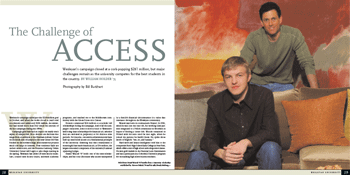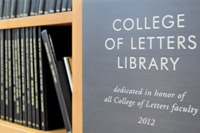The Challenge of Access
 WESLEYAN‘S CAMPAIGN SAILED PAST THE $250-MILLION GOAL IN OCTOBER, and when the books closed at year’s end on a historic and celebratory $281 million, the university had raised more than four times the amount of the last campaign during the 1980s.
WESLEYAN‘S CAMPAIGN SAILED PAST THE $250-MILLION GOAL IN OCTOBER, and when the books closed at year’s end on a historic and celebratory $281 million, the university had raised more than four times the amount of the last campaign during the 1980s.
Campaign gifts have had an impact on nearly every aspect of campus life. Most obvious are facilities that range from an addition to the Freeman Athletic Center on the south side of campus to the new Center for Film Studies on the northern edge, with numerous projects small and large in between. New residence halls are under construction, and the Suzanne Lemberg Usdan University Center will begin to take shape starting in the spring. Wesleyan has added 20 new faculty members, created new faculty chairs, endowed academic programs, and reached out to the Middletown community with the Green Street Arts Center.
Donors committed $58 million to establish 140 scholarships during the campaign. And of all the campaign’s initiatives, none is more crucial to Wesleyan’s well-being than scholarships for financial aid, whether they are endowed in perpetuity or for discrete time periods. For decades, successive administrations have held up need-blind access as a fundamental principle of the university. Ensuring that this commitment is meaningful has made financial aid, at $36 million, the largest non-salary component of the university’s annual operating budget.
Dawid Wiacek ’07 holds one of the new scholarships, and his story illustrates why access unimpeded by a family’s financial circumstances is a value that resonates throughout the Wesleyan community.
Wiacek was born in southeastern Poland. In 1985, when he was just one year old, his working class parents emigrated to a Polish community in Brooklyn in hopes of finding a better life. Wiacek remained in Poland with his aunt until he was eight, when he joined the parents he hardly knew. He spoke three words of English: “yes, no, and banana.”
Hard work and innate intelligence took him to the competitive Bard High School Early College in New York, which offers a mix of high school and college-level classes. He won gold medals in the National Latin Examination and was a participant in a Columbia University program for outstanding high school science students.
When it came time to apply to college, Wesleyan was already high on his list because he had met alumni who were enthusiastic about their experiences. Since his family’s financial circumstances are modest (his father is a factory worker; his mother is a housekeeper), he needed a great deal of financial support. Wesleyan’s offer of the Belzberg University Scholarship clinched his decision.
That’s just what former Wesleyan Trustee Strauss Zelnick ’79 hoped would happen when he and his wife, Wendy Belzberg, established the Samuel and Frances Belzberg Endowed University Scholarship in honor of Wendy’s parents. University scholarships are designed to appeal to top applicants. They offer an attractive package of need-based grants and lower loan expectations accompanied by summer stipends and the opportunity to work with faculty on research.
Zelnick, a partner in the diversified media holding company ZelnickMedia, and well-known in the recording and movie industries, says that University Scholarships provide Wesleyan with a compelling recruitment tool that enhances diversity. “We’re able to use that tool to attract the best and the brightest who might not be able to attend Wesleyan for financial reasons or might choose to attend one of our competitor schools.”
As part of his scholarship, Wiacek has worked with Assistant Professor of Psychology Regina Langhout on a project at a local elementary school. He also made use of the summer stipend to work in Honduras building a house and learning Spanish. “I’ve never worked so hard physically in my life,” he says.
The opportunity to become acquainted with the Zelnicks, he adds, has been a delightful added benefit—a sentiment that Zelnick said he strongly shares.
Wesleyan offers 10 University Scholarships per class. Dean of Admission and Financial Aid Nancy Hargrave Meislahn says that students “have turned down Ivies and other places like Williams and Swarthmore to accept a place at Wesleyan because of the added plus of faculty mentorship and research.”
Throughout a decade at Wesleyan, President Douglas J. Bennet ’59 has been a staunch proponent of Wesleyan’s need-blind admission and need-based financial aid policies. Bennet is motivated by a deep belief in the principle of meritocratic access and by his recognition that abandoning this policy would separate Wesleyan from the group of top colleges and universities. Bennet’s concerns also extend beyond Wesleyan to what he views as serious problems concerning access to higher education in the United States and a deterioration in the ability of families to pay for ever-rising costs.
“The rising cost of higher education will exclude hundreds of thousands of qualified students from earning a college degree,” he says. “Like health care, education has many expenses that cannot be artificially limited if we, in the United States, want to continue to be the best and do our best. We can’t outsource teaching.
“Clearly, the price of a college education is also a hardship for middle-income families who continue to take on greater amounts of debt in lieu of financial aid.”
The Advisory Committee on Student Financial Assistance, created by Congress to improve access to higher education, estimates that every year about 170,000 students give up on college because of costs. Observers hold out little hope that Congress will ameliorate this problem as it grapples with reauthorization this year of the Higher Education Act, the law that governs most federal financial aid programs. Moreover, the Department of Education recently tightened eligibility requirements for Pell grants—a move expected to remove up to 90,000 students from consideration for this cornerstone of aid for low-income students.
Students who receive Pell grants are by no means out of the financial woods. In 1976, Pell grants covered 72 percent of the average price of attending a four-year college, but that figure today is only 34 percent. As a result, low-income families have seen the cost of tuition rise from 13 percent of family income to 25 percent.
As support from the federal government has diminished in relative terms, Wesleyan has made up the difference, as its peer institutions have done, by increasing its own financial aid funds.
Other trends also have worked against students from the poorest families. Although total federal financial aid funding has increased three-fold in recent decades, much of that increase has come as loans. Research has shown that students from lower-income families are less willing to borrow for higher education than their wealthier peers, according to the National Association of Student Financial Aid Administrators. On top of that, a larger share of grant aid is being used for merit programs, and such programs tend to benefit students from higher-income families. In effect, these funds are protecting affordability for the middle and upper classes.
Access has become a defining issue in higher education, made all the more important by research showing that few students from families in the nation’s lower half of the income distribution attend elite colleges. Data from the Campus Equity Web site, sponsored by the Pell Institute, shows that only 6 percent of Harvard undergraduates and 11 percent of Stanford undergraduates received Pell grants in 2000–01, compared to, for example, 56 percent at California State University, Dominguez Hills (at Wesleyan, it’s 13 percent). Harvard and Stanford may enroll economically disadvantaged students who are not receiving Pell grants, but the figures support a well-documented trend: lower income students are much more likely to attend two-year community colleges and non-selective four-year institutions than selective colleges.
Academic preparation accounts for some of that trend, but for how much? Is there more that colleges and universities can do to open their doors to qualified low-income students?
In 2001, Princeton announced that it would eliminate loans entirely for financial aid students and replace them with outright grants. Among major public institutions, the universities of Virginia and North Carolina also have taken steps to reduce loan levels for scholarship students.
Last year Harvard announced it would stop asking parents who earn less than $40,000 to make any contribution to their child’s education. Officials had discovered that many students were paying the parental contribution themselves because their families could not afford to do so. In January 2005, Williams College announced reductions in loan debt based on a sliding scale of family income.
These actions have not set off a stampede among private colleges to eliminate loans, but many institutions have cut back on loan debt levels, using strong endowment returns to finance the very sizeable demands that such policies place on operating income.
During the course of the campaign, Wesleyan reduced the maximum loan that a student would be expected to acquire over four years from $28,000 to $20,000. The action added $6 million to the university’s annual operating budget. Although this step left Wesleyan still above the median of loan levels among peer institutions, it has had a significant impact.
“The Board commitment to lower loan levels was very important in keeping our aid competitive,” says Meislahn. “It’s a powerful tool in recruitment conversations.”
Yet by the end of the campaign, Wesleyan reluctantly modified its policy to allow the maximum loan debt level to rise gradually as tuition increases year by year. The revised policy represents a delicate balancing among affordability to students, the university’s competitive position, and the university’s financial resources. It is also a frank admission of the strain financial aid places on the budget.
University officials believe that Wesleyan’s aid remains sufficiently competitive that few admitted students are choosing other institutions based on aid packages, though admission officials continue to monitor this area closely. No one, however, is suggesting that Wesleyan should be content with the status quo. Meislahn points out that the demographic growth in high school students is taking place largely outside Wesleyan’s traditional Northeastern markets and reflects a more racially diverse pool. To maintain and increase its competitive position, Wesleyan needs to recruit these students. A strong financial aid program will remain a critical tool in that effort.
A draft of Wesleyan’s new five-year strategy, which has been posted on the university’s Web site for comment, notes that while Wesleyan compares favorably with peers on the family contribution expected of students who receive financial aid, loan levels remain above peer institutions.
“To stay in the game,” the document continues, “Wesleyan needs to continue to raise funds for scholarships and increase endowment for financial aid.”
Kofi Appenteng ’81, a trustee who chairs the Board’s committee that oversees fundraising and has chaired the committee with responsibility for admission, says that he believes the Board has no priority higher than supporting financial aid.
“It’s the way to get the best students and to focus our decision-making on the qualities of applicants solely,” he says. “In the post-campaign period, there is no doubt that financial aid will remain among the highest of our priorities. Our hope is that we will be able to get back, in a disciplined way, to the $20,000 loan debt maximum and maybe even do better than that.”
The draft strategy outlines another way of addressing the loan issue: through forgiveness of loans for students entering careers in social or public service and nonprofit or education sectors. Wesleyan may consider further reducing loan levels for the most economically disadvantaged students.
Although the challenge posed by need-blind access is considerable for Wesleyan, the rewards of Wesleyan’s commitment are incalculable. They come one student at a time—young people such as Ruby Ross, a freshman from Tandem Friends School in Charlottesville, Va. Accomplished in French, she was invited to study at the highly selective Governor’s School Foreign Language Academy in Staunton. She is a published poet, a painter, and was a member of the Virginia Consort Youth Chorale.
She lives with her mother, a massage therapist, and could never have attended Wesleyan without a large scholarship. “Wesleyan made it possible,” she says.
She is the recipient of the Mary Ann Hunting Endowed Scholarship, established by Sarah Killough-Dhar ’88 in honor of her grandmother. Killough-Dhar is one of Wesleyan’s new generation of generous donors.
“I wanted to show that the ‘young bloods’ can give at high levels, too,” she says. “And that what they gave could change so many lives for the better.”


